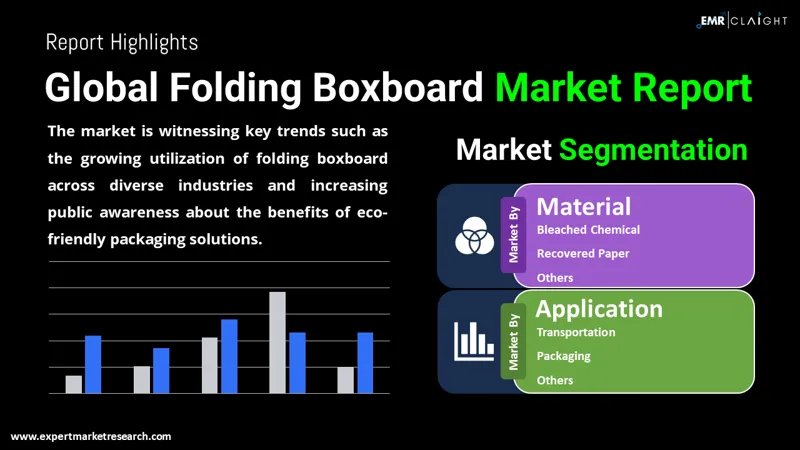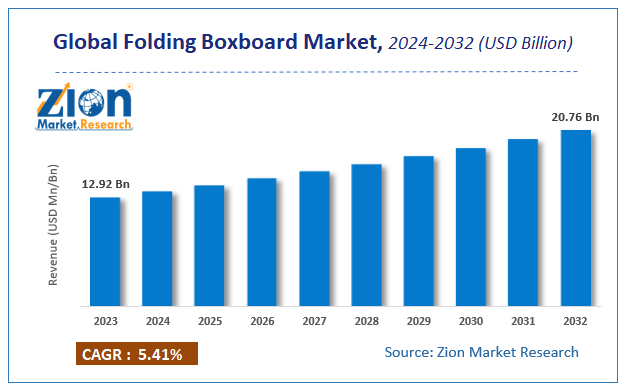Is the Folding Boxboard Market on the Rise?
Folding Boxboard Market Overview
According to industry experts, the folding boxboard market is poised for significant growth in the coming years. With increasing consumer demand for eco-friendly packaging solutions, the market is expected to reach a value of $20.3 billion by 2032. In this section, we will explore what folding boxboard is, its usage in packaging, the market size, growth projections, and key players in the industry.
What is Folding Boxboard (FBB) and its Usage in Packaging?
Folding boxboard, also known as FBB, is a type of paperboard made from chemical pulp using virgin fibers. It is specifically designed for low-density packaging applications that require both durability and stiffness. The unique properties of FBB, such as its lightweight nature and excellent printability, make it a popular choice for various retail products.
FBB packaging is widely used in industries such as food and beverage, medicine, cosmetics, cards, books, and magazine covers. Its high brightness, caliper, bulk, and stiffness make it an ideal material for packaging applications. The three-layer structure of FBB, with the outer layers made from chemical pulp and the middle layer made from bleached chemi-thermomechanical pulp (BCTMP), gives it the perfect balance of strength and printability.
Market Size and Growth Projections for the Folding Boxboard Industry
The folding boxboard market has been witnessing significant growth in recent years. Factors contributing to this growth include increased demand in the food, beverage, medicine, and cosmetics sectors, rising disposable incomes, manufacturing innovations, and the surge in online retailing. Additionally, the growing focus on sustainability has further propelled the demand for FBB packaging.
According to a report by Smithers, the folding carton market, which includes FBB packaging, is expected to grow by 2.5% in 2021 and over 5% in 2022, primarily driven by sustainability trends. The report also projects that the global folding boxboard consumption will reach nearly 70 million tons by 2028, with a value of around $215 billion.
In terms of regional growth, African markets are showing high growth rates from a low base, while Asian markets exhibit moderate growth from a higher starting point. Europe currently dominates the folding boxboard market, accounting for over 40% of the market share. However, other regions are also expected to experience significant growth in the coming years.
Key Players in the Folding Boxboard Market
The folding boxboard market is highly competitive, with several key players leading the industry. These companies focus on product innovation and sustainability to gain a competitive edge. Some of the key players in the folding boxboard market include:
- International Paper Company: With a strong global presence, International Paper is one of the leading manufacturers of paper-based packaging solutions, including FBB packaging.
- Stora Enso: Stora Enso is a leading provider of renewable solutions in packaging, biomaterials, wood, and paper. They offer a wide range of folding boxboard products to meet the diverse packaging needs of their customers.
- Mayr-Melnhof Karton: Mayr-Melnhof Karton is a prominent supplier of cartonboard and folding cartons. They offer sustainable packaging solutions, including FBB, to customers across various industries.
These companies, along with other players in the market, continue to invest in research and development to introduce innovative and sustainable solutions in the folding boxboard industry.
In conclusion, the folding boxboard market is experiencing significant growth, driven by consumer demand for sustainable packaging solutions. The market is expected to reach a value of $20.3 billion by 2032, with key players such as International Paper Company, Stora Enso, and Mayr-Melnhof Karton leading the industry. As the global focus on sustainability increases, the demand for FBB packaging is expected to continue growing, making it a lucrative market for players in the industry.
Factors Driving Growth in the Folding Boxboard Market
Consumer demand for environmentally sustainable solutions has been a key driver for the growth of the folding boxboard market. As awareness about the impact of packaging on the environment increases, consumers are seeking eco-friendly alternatives. Folding boxboard, also known as FBB, addresses sustainability concerns by using renewable fibers and saving energy in its production process. This has made it a popular choice among consumers and businesses across various industries.
In addition to consumer demand, the food, beverage, medicine, and cosmetics industries have also played a significant role in driving the growth of the folding boxboard market. These industries rely heavily on packaging to protect their products and ensure their quality. Folding boxboard offers unique design capabilities, cost-effectiveness, and customization options, making it an attractive choice for packaging solutions.
Technological innovations and sustainability initiatives have further propelled the growth of the folding boxboard market. Advancements in manufacturing processes and materials have led to the development of more sustainable and efficient packaging options. Companies are investing in research and development to enhance the properties of folding boxboard and make it more environmentally friendly.
Sustainability initiatives by governments, regulatory bodies, and industry associations have also contributed to the growth of the folding boxboard market. These initiatives aim to reduce the environmental impact of packaging materials and promote the use of sustainable alternatives. As a result, businesses are increasingly adopting folding boxboard to meet regulatory requirements and consumer expectations.
In summary, consumer demand for sustainable solutions, increasing demand in key industries, and technological innovations and sustainability initiatives are driving the growth of the folding boxboard market. Businesses are recognizing the need for eco-friendly packaging options and are turning to folding boxboard for its numerous benefits. With the continued focus on sustainability and the rising demand for packaged products, the folding boxboard market is expected to experience significant growth in the coming years.
Challenges Faced by the Folding Boxboard Market
The folding boxboard market, like any other industry, faces its fair share of challenges. Understanding and addressing these challenges is crucial for companies to stay competitive and thrive in the market.
Volatility in Raw Material Prices
One of the significant challenges faced by the folding boxboard market is the volatility in raw material prices. The cost of raw materials used in the production of folding boxboard, such as chemical pulp, can fluctuate due to various factors like supply and demand dynamics, changes in trade policies, and natural disasters. These price fluctuations can impact the production costs and profitability of companies in the industry.
Competition from Alternative Packaging Materials
In the ever-evolving packaging industry, folding boxboard faces stiff competition from alternative packaging materials, particularly plastics. Plastics offer advantages like durability, lightweight, and cost-effectiveness, which make them attractive to some manufacturers. To stay relevant and competitive, the folding boxboard market must continuously innovate and highlight its unique selling points, such as sustainability and eco-friendliness.
Regulatory Compliance Challenges
The folding boxboard market is subject to various regulations and standards related to packaging materials and sustainability. Meeting these regulatory requirements can pose challenges for companies, especially those operating in multiple regions with different regulations. Companies must invest in research and development to develop packaging solutions that comply with regulations while still meeting customer demands.
Future Projections and Growth Estimates for the Folding Boxboard Market
Despite the challenges faced by the folding boxboard market, the industry’s future looks promising. Several factors contribute to the projected growth of the market in the coming years.
Increasing Demand for Sustainable Packaging
As consumers become more environmentally conscious, the demand for sustainable packaging solutions like folding boxboard is expected to increase. Folding boxboard offers benefits such as recyclability, renewable fibers, and energy savings, making it an attractive option for eco-minded consumers. The growing awareness and emphasis on sustainable practices are projected to drive the growth of the folding boxboard market.
Growth in Food, Beverage, Medicine, and Cosmetics Industries
The folding boxboard market is expected to witness significant growth due to increased demand in various industries. The food, beverage, medicine, and cosmetics industries are among the key sectors driving the demand for folding boxboard packaging. The need for reliable and visually appealing packaging solutions in these industries is projected to fuel the market’s growth.
Technological Innovations Driving Market Growth
Technological advancements and innovations play a vital role in shaping the future of the folding boxboard market. Companies are investing in research and development to enhance the properties of folding boxboard, such as printability, stiffness, and durability. These advancements not only improve the overall quality of folding boxboard packaging but also open up new possibilities for its usage in different industries.
Competitive Landscape and Strategies for Companies in the Market
The folding boxboard market is highly competitive, with several key players vying for market share. To thrive in this competitive landscape, companies must adopt effective strategies.
Product Innovation
Continuous product innovation is a critical strategy for companies in the folding boxboard market. By developing new packaging designs, enhancing product features, and leveraging advancements in materials and printing technologies, companies can differentiate themselves from competitors. Innovative packaging solutions that meet changing consumer demands and industry trends can give companies a competitive edge.
Sustainability Focus
Given the increasing importance of sustainability, companies emphasizing environmentally friendly packaging solutions have a significant advantage. By promoting the sustainability credentials of folding boxboard, such as its use of renewable fibers, recyclability, and energy-saving properties, companies can attract environmentally conscious consumers. Incorporating sustainable practices in their manufacturing processes and supply chains can further enhance their competitive position.
Collaborations and Partnerships
Collaborations and partnerships with other players in the value chain can help companies in the folding boxboard market strengthen their market position. By working together, companies can leverage each other’s expertise, resources, and networks to drive innovation, streamline operations, and expand their customer base. Collaborations can also enable companies to access new markets and offer comprehensive packaging solutions to customers.
In conclusion, while the folding boxboard market faces challenges such as volatile raw material prices, competition from alternative packaging materials, and regulatory compliance, it also offers significant growth opportunities. The increasing demand for sustainable packaging, growth in key industries, and technological innovations are projected to drive the market’s growth. To succeed in this competitive landscape, companies need to focus on product innovation, sustainability, and foster collaborations and partnerships to stay ahead of the competition and meet customer demands.
Table 1: Global Folding Boxboard Market Size and Growth Projections
| Year | Market Size (Million Tons) | Market Value (Billion USD) |
|---|---|---|
| 2021 | 50.1 | 162.2 |
| 2022 | 53.1 | 176.4 |
| 2023 | 56.3 | 193.7 |
| 2024 | 59.6 | 214.2 |
| 2025 | 63.0 | 238.2 |
Table 2: Key Players in the Folding Boxboard Market
| Company Name | Market Share (%) |
|---|---|
| International Paper | 25% |
| Stora Enso | 18% |
| Mayr-Melnhof Karton | 12% |
| Other Players | 45% |
The tables above provide an overview of the global folding boxboard market size and growth projections, as well as the market share of key players in the industry. These tables help visualize the data mentioned in the blog post and provide a quick reference for readers.
FAQs about Folding Boxboard Market:
What is Folding Boxboard (FBB) and its Usage in Packaging?
To understand Folding Boxboard (FBB) and its usage in packaging, it is essential to note that FBB is a type of paperboard specifically designed for low-density packaging applications that require durability and stiffness. Its properties like lightweight nature and excellent printability make it popular for various retail products.
What are the Market Size and Growth Projections for the Folding Boxboard Industry?
Market size and growth projections for the folding boxboard industry involve factors such as the expected value of $20.3 billion by 2032 due to increased demand in sectors like food, beverage, medicine, cosmetics, sustainability trends, and global consumption reaching nearly 70 million tons by 2028.
Who are the Key Players in the Folding Boxboard Market?
The folding boxboard market features prominent companies like International Paper Company, Stora Enso, and Mayr-Melnhof Karton, emphasizing product innovation and sustainability to stay competitive and meet the diverse packaging needs of customers.
What Drives Growth in the Folding Boxboard Market?
To understand the growth in the folding boxboard market, key factors include consumer demand for sustainable solutions, demand in industries like food, beverage, medicine, and cosmetics, and technological innovations driving advancements in manufacturing processes and materials.
What Challenges are Faced by the Folding Boxboard Market?
Challenges faced by the folding boxboard market consist of volatility
In conclusion, Folding Boxboard Market Overview delves into FBB usage, growth projections, and key players. Consumer demand fuels growth, alongside sustainability initiatives and market segmentation. Challenges persist in the industry, but future projections remain optimistic with evolving strategies.





